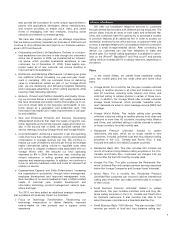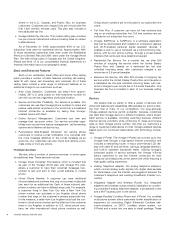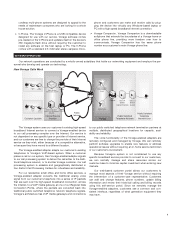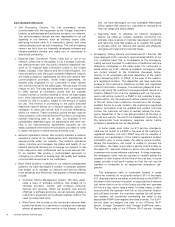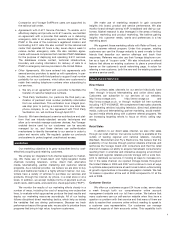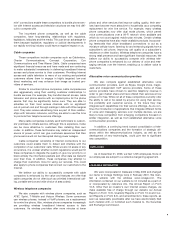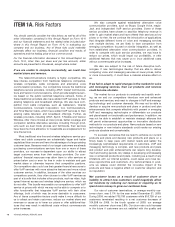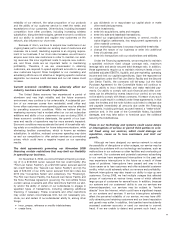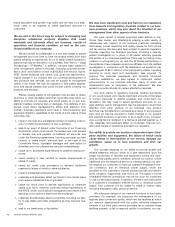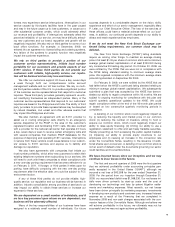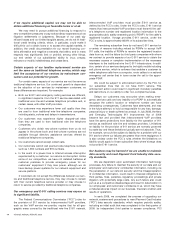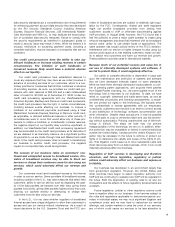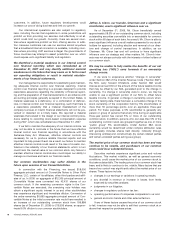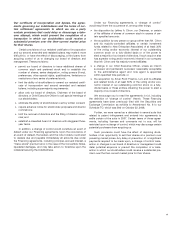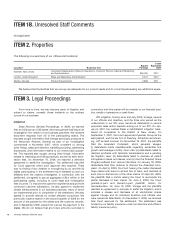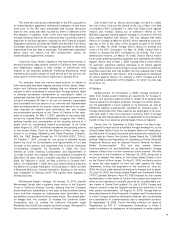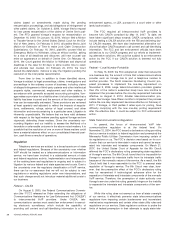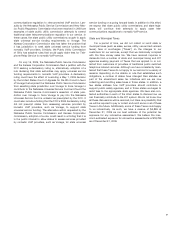Vonage 2009 Annual Report Download - page 19
Download and view the complete annual report
Please find page 19 of the 2009 Vonage annual report below. You can navigate through the pages in the report by either clicking on the pages listed below, or by using the keyword search tool below to find specific information within the annual report.reliability of our network, the value proposition of our products
and the ability of our customer service to meet the needs and
expectations of our customers. Other factors, including increased
competition from other providers, including increasing wireless
substitution, disruptive technologies, general economic conditions
and our ability to activate and register new customers on the
network, also influence our churn rate.
Because of churn, we have to acquire new customers on an
ongoing basis just to maintain our existing level of customers and
revenues. As a result, marketing expense is an ongoing require-
ment of our business. If our churn rate increases, we will have to
acquire even more new customers in order to maintain our exist-
ing revenues. We incur significant costs to acquire new custom-
ers, and those costs are an important factor in maintaining
profitability. Therefore, if we are unsuccessful in retaining
customers, are required to spend significant amounts to acquire
new customers beyond those budgeted or our marketing and
advertising efforts are not effective in targeting specific customer
segments, our revenue could decrease and our net losses could
increase.
Current economic conditions may adversely affect our
industry, business and results of operations.
The United States economy has experienced a period of
slowdown and very high volatility and the future economic
environment may continue to be unfavorable. A substantial por-
tion of our revenues comes from residential, small office and
home office customers whose spending patterns may be affected
by prevailing economic conditions. While we believe that the
weakening economy had a modest effect on our net subscriber
additions and ability of our customers to pay us during 2009, if
these economic conditions deteriorate, the growth of our busi-
ness and results of operations may be more severely impacted.
Economic conditions may accelerate the trend of households rely-
ing solely on a mobile phone for home telecommunications, while
eliminating landline connections, which is known as wireless
substitution. In addition, reduced consumer spending may drive
us and our competitors to offer certain services at promotional
prices, which could have a negative impact on our operating
results.
The debt agreements governing our November 2008
financing contain restrictions that may limit our flexibility
in operating our business.
On November 3, 2008, we consummated a financing consist-
ing of (i) a $130,300 senior secured first lien credit facility (the
“First Lien Senior Facility”), (ii) a $72,000 senior secured second
lien credit facility (the “Second Lien Senior Facility”) and (iii) the
sale of $18,000 of our 20% senior secured third lien notes due
2015 (the “Convertible Notes” and collectively, the “Financing”).
The First Lien Senior Facility, the Second Lien Senior Facility and
the Note Purchase Agreement governing the Convertible Notes
contain various covenants and other restrictions that limit our abil-
ity and/or the ability of certain of our subsidiaries to engage in
specified types of transactions, including obtaining additional
financing, if necessary. These covenants and other restrictions
may under certain circumstances limit, but not necessarily pre-
clude, our and certain of our subsidiaries’ ability to, among other
things:
>incur, prepay, refinance or modify indebtedness;
>create liens;
>pay dividends on or repurchase our capital stock or make
other restricted payments;
>make investments;
>enter into acquisitions, sales and mergers;
>enter into sale and leaseback transactions;
>amend our organizational documents, or amend, modify or
waive litigation settlements, key employment agreements or
other material contracts;
>incur marketing expenses in excess of specified thresholds;
>change the nature of our business or enter into additional
lines of business; and
>enter into transactions with our stockholders and affiliates.
Under the Financing agreements, we are required to maintain
a specified minimum fixed charge coverage ratio, maximum
leverage ratio and senior secured debt leverage ratio. In addition,
these agreements require us to maintain minimum levels of con-
solidated adjusted EBIDTA, liquidity and pre-marketing operating
income and limit our capital expenditures. Upon the repayment of
our obligations under the First Lien Senior Facility and the Second
Lien Senior Facility, the covenants will fall-away, but the Note
Purchase Agreement for the Convertible Notes will continue to
limit our ability to incur indebtedness and make restricted pay-
ments. Our ability to comply with such financial and other cove-
nants can be affected by events beyond our control, so we may
not be able to comply with these covenants. A breach of any such
covenant could result in a default under these agreements. In that
case, the lenders and the note holders could elect to declare due
and payable immediately all amounts due under the Financing
agreements, including principal, accrued interest, a “make-whole”
premium and, in the case of the Convertible Notes, liquidated
damages, and may take action to foreclose upon the collateral
securing the indebtedness.
Flaws in our technology and systems could cause delays
or interruptions of service or permit third parties to com-
mit fraud using our services, which could damage our
reputation, cause us to lose customers and limit our
growth.
Although we have designed our service network to reduce
the possibility of disruptions or other outages, our service may be
disrupted by problems with our technology and systems, such as
malfunctions in our software or other facilities and overloading of
our network. Our customers and potential customers subscribing
to our services have experienced interruptions in the past and
may experience interruptions in the future as a result of these
types of problems. Interruptions have caused and may in the
future cause us to lose customers and offer substantial customer
credits, which could adversely affect our revenue and profitability.
Network interruptions may also impair our ability to sign-up new
customers. During 2009, we had multiple outages that affected
groups of customers at various times, some of which affected
large groups of customers for several hours. In addition, because
our systems and our customers’ ability to use our services are
Internet-dependent, our services may be subject to “hacker
attacks” from the Internet, which could have a significant impact
on our systems and services. If service interruptions adversely
affect the perceived reliability of our service, we may have diffi-
culty attracting and retaining customers and our brand reputation
and growth may suffer. In addition, third parties have fraudulently
accessed customer accounts or used our services to commit
fraud. If we are unable to detect and prevent such fraud, our
11




